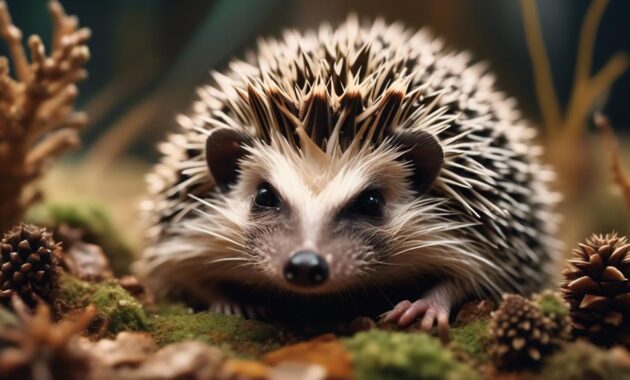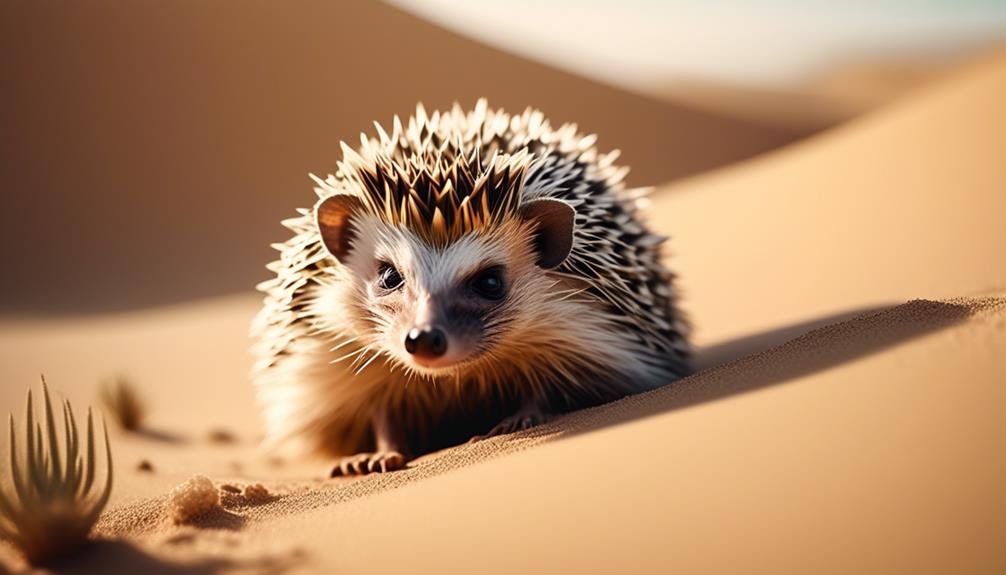
Brandt’s hedgehog, a desert dweller with remarkable running abilities and a distinctive skin, captivates the imagination with its elusive nature and intriguing adaptations.
Found in arid regions and mountains, this hedgehog species possesses unique physical characteristics, such as its large ears and lighter needle protection, enabling it to navigate its environment with agility.
However, what truly sets Brandt’s hedgehog apart from its counterparts is its three-layered skin, a feature that sets the stage for further exploration.
In this discussion, we will delve into the mysteries of this enigmatic creature, unveiling the secrets behind its desert running prowess and the fascinating intricacies of its skin.
Key Takeaways
- Brandt’s hedgehog is similar in size to the West European hedgehog and has large ears.
- It is primarily active at night and is a fast runner due to its lighter needle protection.
- Brandt’s hedgehog prefers arid desert areas and mountains, and it is adapted to survive in arid environments.
- There are multiple subspecies of Brandt’s hedgehog, each with distinct characteristics and distribution.
Description and Physical Characteristics
Brandt’s hedgehog, also known as Paraechinus hypomelas, possesses distinct physical characteristics that set it apart from other hedgehog species. Similar in size to the West European hedgehog, Brandt’s hedgehog weighs about 500-1,000 g and measures 25 cm in length.
One notable feature is its large ears, resembling the long-eared hedgehog. This hedgehog species is a fast runner due to its lighter needle protection. Unlike the long-eared hedgehog, Brandt’s hedgehog is primarily active at night.
Interestingly, a study found that Brandt’s hedgehog has three layers of skin: the epidermis, dermis, and hypodermis, while other hedgehogs have only two. These physical characteristics contribute to its unique appearance and abilities in its natural habitat.
Habitat and Adaptations
Paraechinus hypomelas, commonly known as Brandt’s hedgehog, demonstrates remarkable adaptability to its preferred habitats and possesses unique physiological characteristics that enable it to thrive in arid desert regions and mountains.
Brandt’s hedgehog prefers arid desert areas and mountains, where it often seeks natural shelter and can dig dens when necessary. It is adapted to survive in arid environments and has the ability to hibernate during colder weather.
The species exhibits a preference for desert regions and mountainous areas as its habitat. With its lightweight needle protection and fast running ability, Brandt’s hedgehog has the necessary adaptations to navigate its habitat successfully.
These adaptations and its ability to thrive in challenging environments make Brandt’s hedgehog a fascinating species to study.
Subspecies
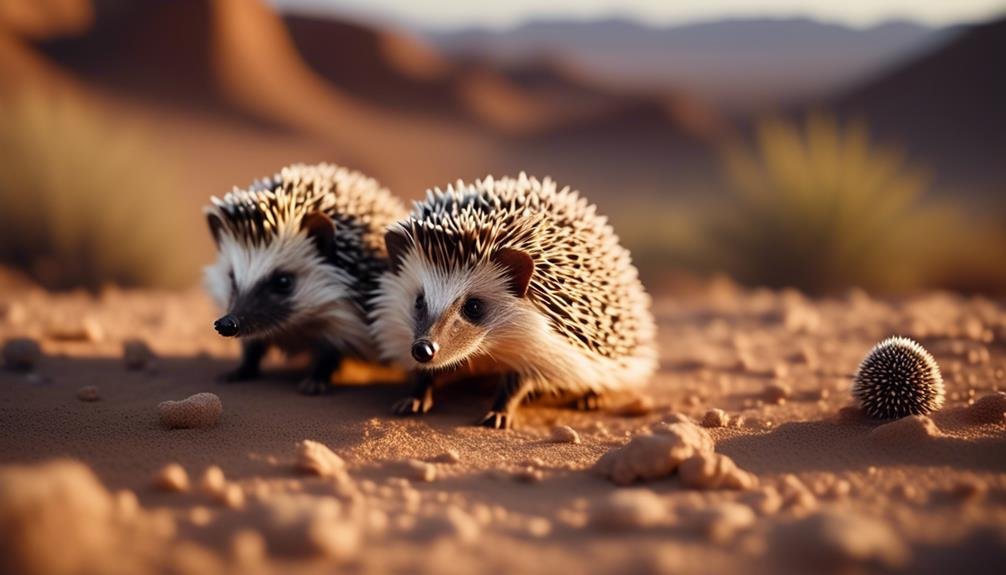
Multiple subspecies of Brandt’s hedgehog exist, each with distinct characteristics and distribution. Among the recognized subspecies are Paraechinus hypomelas blanfordi, Paraechinus hypomelas hypomelas, Paraechinus hypomelas niger, and Paraechinus hypomelas seniculus. These subspecies may vary in terms of physical traits, such as size and coloration, as well as their geographic range.
Paraechinus hypomelas blanfordi is one of the subspecies of Brandt’s hedgehog that has been identified. Another subspecies, Paraechinus hypomelas hypomelas, also exists. Additionally, Paraechinus hypomelas niger is a subspecies found in specific regions.
Understanding the diversity of these subspecies is essential for conservation efforts and studying the evolutionary history of Brandt’s hedgehog. Further research is needed to fully comprehend the unique characteristics and distribution patterns of each subspecies.
References
The following references provide valuable information on Brandt’s hedgehog and its various subspecies, contributing to our understanding of their characteristics, distribution, and conservation status:
- Bhattacharyya, T., Srinivasulu, C., & Molur, S. (2017). Paraechinus hypomelas. IUCN Red List of Threatened Species.
- Hutterer, R. (2005). Mammal Species of the World: A Taxonomic and Geographic Reference.
- Bazm, M. A., Goodarzi, N., Abumandour, M. M. A., Naseri, L., & Hosseinipour, M. (2020). Histological characterisation of the skin of the Paraechinus hypomelas, Brandt, 1836.
- Abe, Y., & Tanaka, N. (2017). Roles of the Hedgehog Signaling Pathway in Epidermal and Hair Follicle Development, Homeostasis, and Cancer.
These references offer a wealth of knowledge on Brandt’s hedgehog and its subspecies, providing insights into their physical characteristics, habitat preferences, and conservation status.
They also shed light on the unique adaptations and ecological roles of hedgehogs within the Erinaceidae family.
Related Species
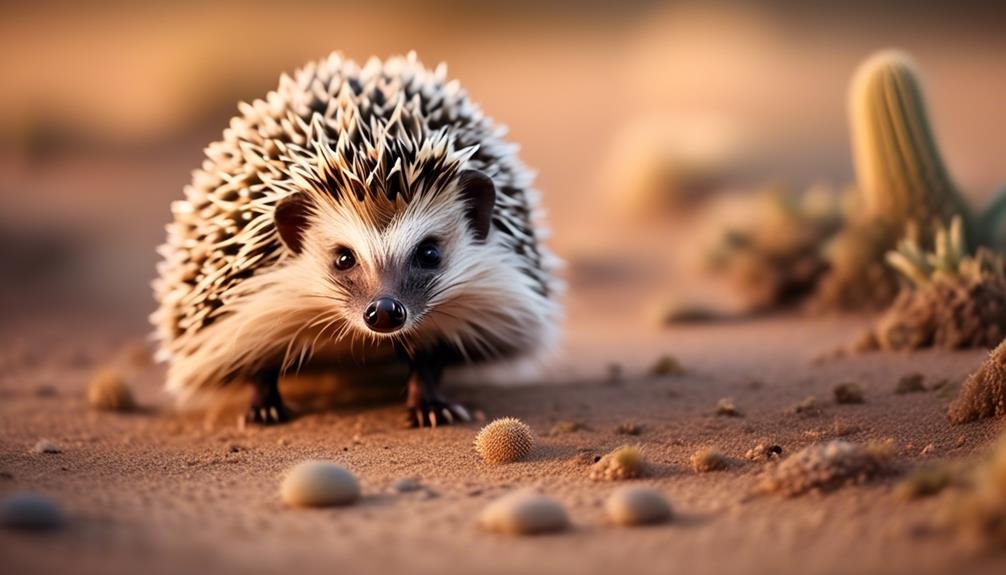
Within the Erinaceidae family, Brandt’s hedgehog is part of a diverse group of species that exhibit a wide range of characteristics and inhabit various regions.
Other species within the family include M. hughi, Gaoligong forest hedgehog, M. wangi, Small-toothed forest hedgehog, M. miodon, H. parvus, Javan short-tailed gymnure, H. suillus, Bornean short-tailed gymnure, H. dorsalis, Max’s short-tailed gymnure, H. maxi, Dalat gymnure, H. macarong, Northern short-tailed gymnure, H. peguensis, Leuser gymnure, and H. vorax, P. truei.
These species exhibit diverse characteristics and inhabit various regions.
The Erinaceidae family includes several species of hedgehogs and gymnures, each with unique adaptations and ecological roles.
The study of these related species provides valuable insights into the evolutionary history, ecological niche, and conservation of Brandt’s hedgehog.
Size and Weight
Brandt’s hedgehog, a member of the Erinaceidae family, exhibits a specific size and weight characteristic that contributes to its unique physical attributes and adaptations. This elusive desert runner weighs between 500-1,000 g and measures approximately 25 cm in length.
The hedgehog’s relatively light weight allows it to be a fast runner, enabling it to escape predators and navigate through its arid desert habitat with agility.
The compact size of Brandt’s hedgehog makes it well-suited for maneuvering through tight spaces and burrows, offering protection and shelter.
Despite its small size, the hedgehog’s weight allows it to have sufficient body mass to withstand harsh desert conditions and fluctuations in temperature.
The specific size and weight of Brandt’s hedgehog are essential for its survival and success in the challenging desert environment.
These distinct size and weight characteristics contribute to the hedgehog’s ability to thrive in its habitat and adapt to the unique challenges of the desert ecosystem.
Unique Ears
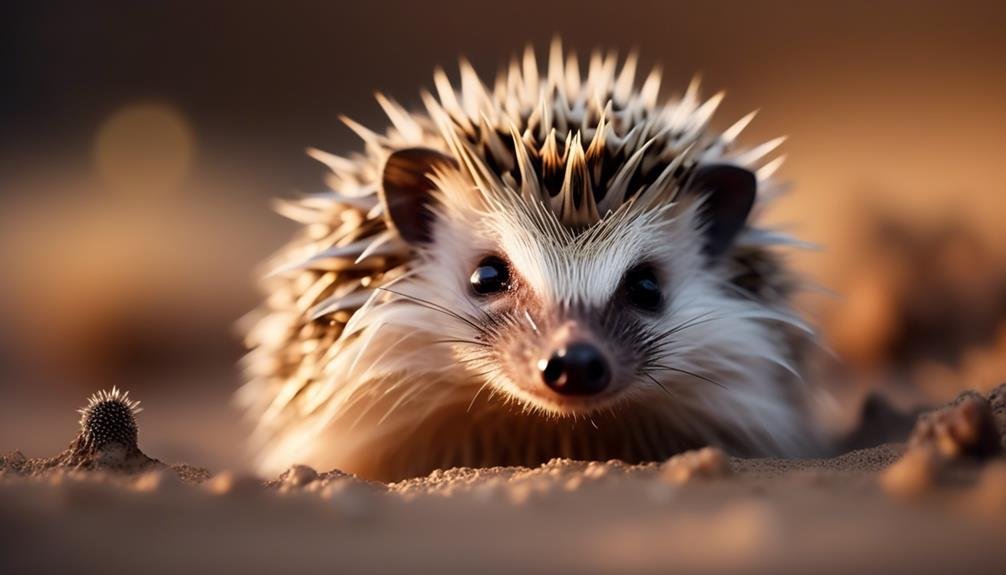
With their distinct size and shape, the ears of Brandt’s hedgehog set it apart from other species within the Erinaceidae family. These hedgehogs have relatively large ears compared to their body size, resembling those of the long-eared hedgehog. The unique ears of Brandt’s hedgehog serve several purposes, including enhancing their ability to detect sounds and aiding in thermoregulation.
Table: Adaptations of Brandt’s Hedgehog Ears
| Adaptation | Description |
|---|---|
| Large Size | The large size of their ears allows Brandt’s hedgehog to capture and amplify sounds in its environment. It helps them to detect predators or prey even in low-light conditions. |
| Mobility | Brandt’s hedgehog can move its ears independently, allowing them to pinpoint the direction of sounds more accurately. This mobility enhances their ability to locate food and avoid potential threats. |
| Blood Vessels and Capillaries | The ears of Brandt’s hedgehog are richly supplied with blood vessels and capillaries. This network of blood vessels helps regulate body temperature by dissipating excess heat through the ears’ surface. It facilitates efficient thermoregulation in hot desert environments. |
| Protection | The spiky quills of Brandt’s hedgehog provide protection for their ears. When threatened, they can curl into a defensive ball, protecting their vulnerable ears from potential harm. |
| Species Identification | The unique size and shape of the ears can also aid in species identification. By studying the characteristics of Brandt’s hedgehog ears, researchers can differentiate it from other hedgehog species within the Erinaceidae family. |
Brandt’s hedgehog’s unique ears play a vital role in its survival in the desert environment. They enable the hedgehog to navigate its surroundings, detect potential dangers, regulate body temperature, and contribute to its overall ecological niche within the Erinaceidae family.
Fast Running Abilities
Renowned for its impressive speed, the Brandt’s hedgehog showcases remarkable running abilities that set it apart from other species within the Erinaceidae family. This desert runner has evolved to excel in its fast-paced lifestyle, allowing it to navigate its arid habitat with ease.
Here are four reasons why the Brandt’s hedgehog is a true sprinter:
- Lighter needle protection: Unlike other hedgehog species, the Brandt’s hedgehog has lighter needle protection, enabling it to move swiftly and effortlessly.
- Adaptation to desert environments: With its unique adaptations, the Brandt’s hedgehog has developed the ability to run at high speeds in arid desert areas.
- Enhanced agility: The hedgehog’s agile nature allows it to maneuver through obstacles and navigate its surroundings quickly.
- Efficient locomotion: The Brandt’s hedgehog possesses a streamlined body and strong limbs, optimizing its running efficiency and enabling it to reach impressive speeds.
These characteristics make the Brandt’s hedgehog a true desert runner, capable of swift and agile movements in its challenging environment.
Nocturnal Behavior
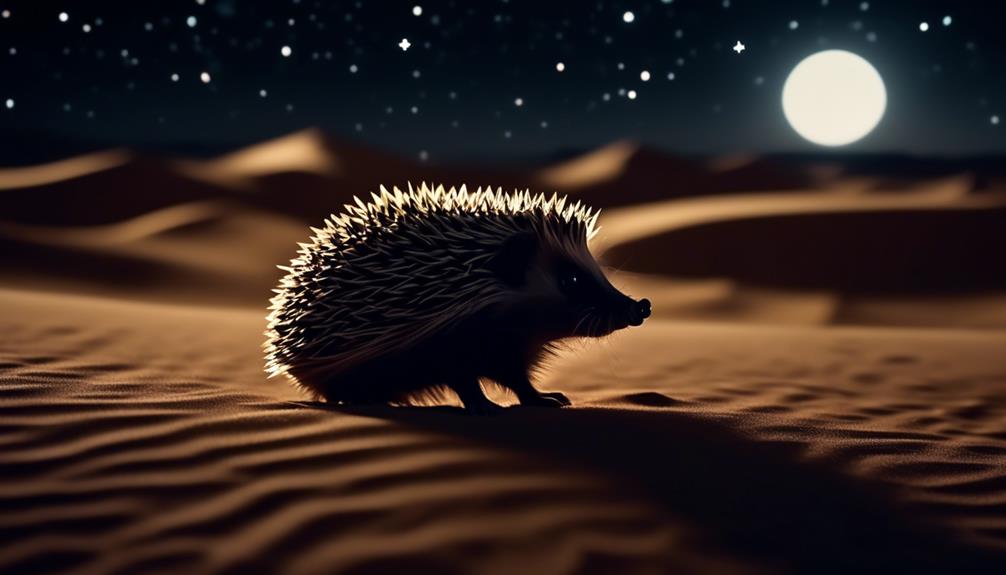
Nocturnal in nature, the Brandt’s hedgehog displays distinct behavioral patterns that contribute to its survival in the desert environment. As a nocturnal species, the hedgehog is primarily active at night, using its well-developed senses to navigate and forage for food under the cover of darkness. This behavioral adaptation allows the hedgehog to avoid the scorching heat of the desert during the day and reduces its risk of predation. Additionally, the Brandt’s hedgehog has unique adaptations that further support its nocturnal lifestyle. Its large ears enable it to detect subtle sounds, aiding in the detection of potential threats or prey. Its eyes are also adapted for low-light conditions, allowing it to see clearly in the dark. These behavioral and physiological adaptations contribute to the Brandt’s hedgehog’s success as a desert runner.
| Nocturnal Behavior of Brandt’s Hedgehog | |
|---|---|
| Behavioral Pattern | Nocturnal |
| Activity Time | Nighttime |
| Senses | Well-developed hearing and sight for low-light conditions |
| Benefits | Avoids daytime heat and reduces risk of predation |
Three Layers of Skin
The unique adaptations of Brandt’s hedgehog extend beyond its nocturnal behavior, as evidenced by its fascinating three layers of skin. While other hedgehogs have only two layers, Brandt’s hedgehog possesses an additional layer that enhances its survival in its arid desert habitat.
This remarkable feature evokes a sense of wonder and appreciation for the hedgehog’s ability to thrive in harsh conditions. The three layers of skin provide the hedgehog with increased protection and insulation, allowing it to withstand extreme temperatures and potential threats.
This adaptation showcases the remarkable resilience of Brandt’s hedgehog and highlights the incredible diversity of adaptations found in the animal kingdom.
Arid Desert Preference
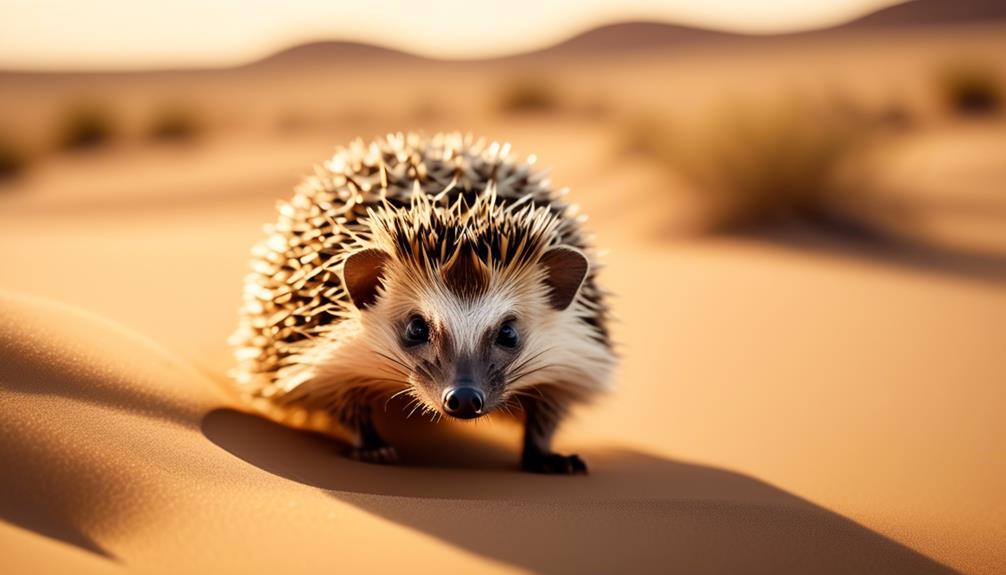
What factors contribute to Brandt’s hedgehog’s preference for arid desert environments?
Brandt’s hedgehog, scientifically known as Paraechinus hypomelas, exhibits a clear preference for arid desert habitats. This preference can be attributed to several factors.
Firstly, the hedgehog’s physical adaptations enable it to survive in such environments. Its lighter needle protection allows for increased agility, making it a fast runner. Additionally, Brandt’s hedgehog has been found to have three layers of skin, providing better protection against the harsh desert conditions.
Secondly, the availability of natural shelters in arid desert areas provides the hedgehog with suitable hiding places during the day.
Lastly, the ability to dig dens when necessary allows the hedgehog to create its own shelter during extreme weather conditions.
These combined factors contribute to Brandt’s hedgehog’s arid desert preference and its ability to thrive in such environments.
Shelter and Denning Habits
Shelter and denning habits play a crucial role in the survival and protection of Brandt’s hedgehog in their arid desert habitat. These unique creatures have developed specific behaviors and adaptations to ensure their safety and well-being. Here are some key aspects of their shelter and denning habits:
- Natural shelters: Brandt’s hedgehogs seek out natural shelters, such as rock crevices or dense vegetation, to protect themselves from predators and harsh weather conditions.
- Digging dens: When necessary, these hedgehogs are capable of digging their own dens in the desert sand, providing them with a secure and secluded space to rest and raise their young.
- Hibernation: During colder weather, Brandt’s hedgehogs enter a state of hibernation, conserving energy and minimizing their exposure to the harsh desert environment.
- Adaptation to arid environments: Brandt’s hedgehogs have evolved to withstand the challenges of arid habitats, utilizing their shelter and denning habits as a means of survival.
Hibernation in Colder Weather

During the colder months, Brandt’s hedgehogs enter a state of hibernation to conserve energy and protect themselves from the harsh conditions of their arid desert habitat. Hibernation is a physiological adaptation that allows these hedgehogs to survive in extreme temperatures.
As the temperature drops, Brandt’s hedgehogs reduce their metabolic rate, heart rate, and body temperature to conserve energy. They find a secure location, such as a burrow or a natural shelter, to minimize exposure to the cold.
During hibernation, their activity levels decrease significantly, and they enter a state of torpor, where their bodily functions slow down. This enables them to endure the colder weather and survive until more favorable conditions return.
Hibernation is a vital survival strategy for Brandt’s hedgehogs in colder climates, allowing them to endure the challenging conditions of their desert habitat.
Frequently Asked Questions
What Is the Average Lifespan of a Brandt’s Hedgehog?
The average lifespan of a Brandt’s hedgehog is approximately 4-6 years in the wild. However, with proper care in captivity, they can live up to 10 years or more.
How Does Brandt’s Hedgehog Communicate With Other Hedgehogs?
Brandt’s hedgehog communicates with other hedgehogs primarily through vocalizations and scent marking. They produce a variety of sounds, including clicks, grunts, and hisses, to convey messages. Scent marking is done by rubbing their bodies against objects to leave behind their unique odor.
What Is the Reproductive Behavior of Brandt’s Hedgehog?
The reproductive behavior of Brandt’s hedgehog involves mating during the breeding season, which varies depending on the subspecies and geographical location. After a gestation period of around 40 days, the female gives birth to a litter of 2-5 young, which she cares for until they are independent.
What Is the Diet of Brandt’s Hedgehog in Its Natural Habitat?
Brandt’s hedgehog has an omnivorous diet in its natural habitat, consisting of insects, small vertebrates, plant matter, and fruits. This adaptable diet allows the hedgehog to thrive in its arid desert and mountainous habitats.
Are Brandt’s Hedgehogs Commonly Kept as Pets?
Brandt’s hedgehogs are not commonly kept as pets due to their specialized needs and specific habitat requirements. They are adapted to arid desert environments and have unique skin characteristics, making them more suitable for wild habitats rather than domestic settings.
Conclusion
In conclusion, the Brandt’s hedgehog is a fascinating creature with unique characteristics and adaptations that allow it to thrive in arid desert environments. Its elusive nature, desert running capabilities, and three layers of skin make it a remarkable species within the Erinaceidae family.
With its natural shelter and hibernation habits, the Brandt’s hedgehog demonstrates its ability to survive and conserve energy in harsh conditions. This species serves as a testament to the remarkable diversity and ecological roles of hedgehogs and gymnures.

